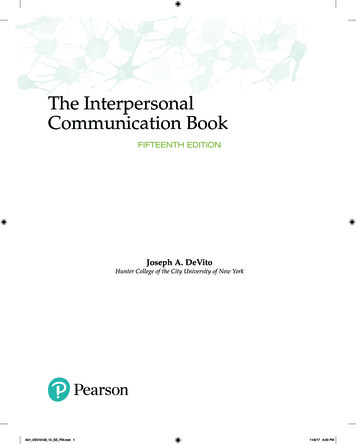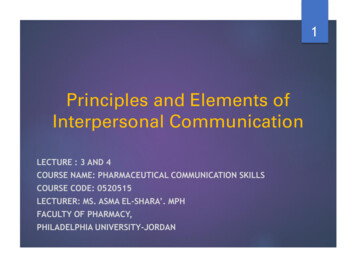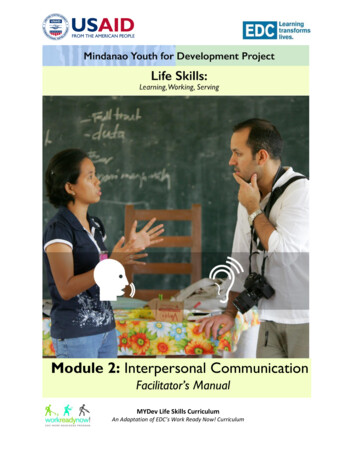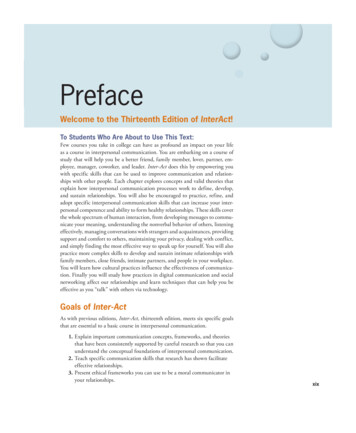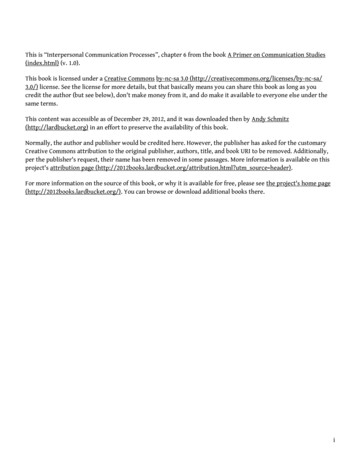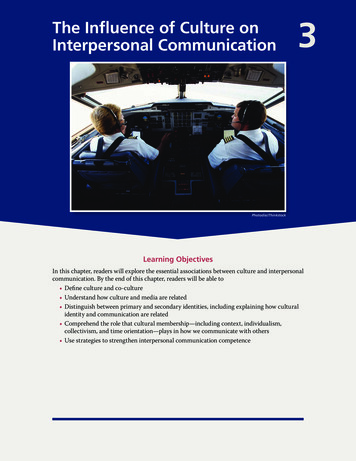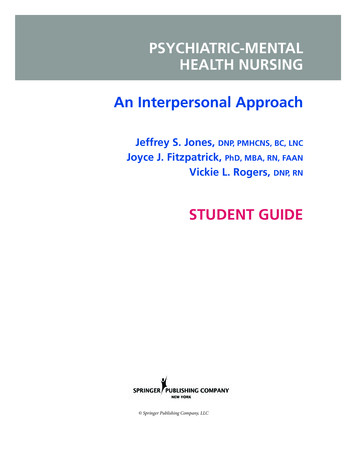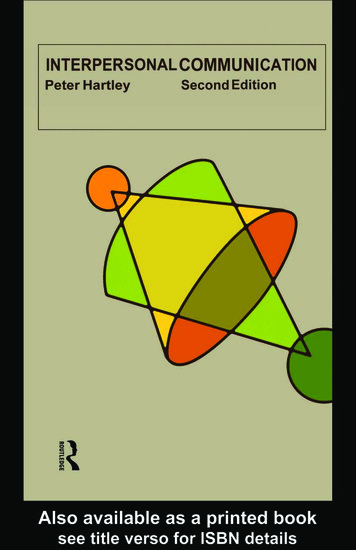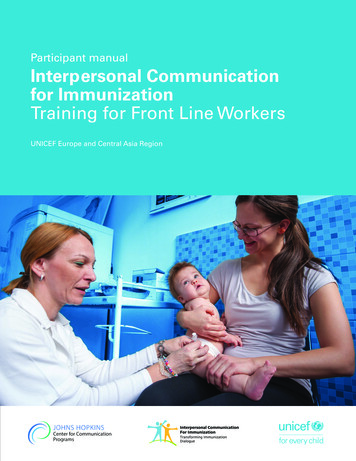
Transcription
1Participant manualInterpersonal Communicationfor ImmunizationTraining for Front Line WorkersUNICEF Europe and Central Asia Region
2Interpersonal Communication for Immunization. Participant manual
Participant manualInterpersonal Communicationfor ImmunizationTraining for Front Line WorkersUNICEF Europe and Central Asia Region
4Interpersonal Communication for Immunization. Participant manualAcknowledgementsThis training package was developed by the Johns Hopkins Center for Communication Programs, theUNICEF Europe and Central Asia Regional Office, and UNICEF Country Office staff in Bosnia andHerzegovina and Serbia.We would like to thank Sergiu Tomsa, UNICEF Regional Communication for Development Specialist,Mario Mosquera, UNICEF Regional Communication for Development Adviser and Svetlana Stefanet,UNICEF Regional Immunization Specialist, for their significant contributions to its conceptualizationand development.We also thank Fatima Cengic, Health and Nutrition Specialist, UNICEF Bosnia and Herzegovina andJelena Zajeganovic-Jakovljevic, Early Childhood Development Specialist, UNICEF Serbia, as well asDragoslav Popovic, consultant, the representatives of Institutes of Public Health, academia, healthworkers, Roma community mediators and civil society organizations from both countries for theirsupport and active engagement in pre-testing and finalizing the package.The materials are based on state-of-the-art resources from UNICEF, the World Health Organization(WHO), European and American Centers for Disease Control, academic journals and the immunizationwebsites of a range of governments and foundations.Authors:Robert Karam, Johns Hopkins Center for Communication ProgramsWaverly Rennie, Consultant, Johns Hopkins Center for Communication ProgramsStephanie Clayton, Johns Hopkins Center for Communication ProgramsDesign: Benussi&theFishCover Photo: UNICEF/UN040868/Bicanski United Nations Children’s Fund (UNICEF), 2019. Some rights reserved.This work is available under the Creative Commons Attribution-NonCommercial-ShareAlike 3.0 IGOlicense (CC BY-NC-SA 3.0 IGO; igo).The opinions expressed in this guide are those of the authors and do not necessarily reflect the policiesor views of UNICEF.
5Table of ContentsIntroduction. 12Intended use and audience . 13Module 1. Introduction and overview. 14Session 1.1. Introductions and immunization challenges . 15Session 1.2. Review of training objectives, agenda, and housekeeping . 15Session 1.3. Pre-test and distribution of Participant manuals . 16Session 1.4. FLWs’ experiences with immunization. 16Session 1.5. Assignments for module summaries.17Module 2. Immunization technical review. 19Session 2.1. How vaccines work and health benefits.19Session 2.2. National coverage trends and vaccine schedule. 23Session 2.3. Vaccine safety processes and protocols in Serbia.31Session 2.4. Vaccine hesitancy . 33Module 3. Understanding behaviour and barriers . 38Session 3.1. Understanding models of behaviour change . 38Session 3.2. Perception biases. 44Session 3.3. Diagnosing your caregivers’ needs. Introduction . 50Session 3.4. Mapping your caregivers on the Continuum of vaccine hesitancy. 53Session 3.5. Common fears and beliefs about vaccines. 56Module 4. Active listening to understand your caregiver. 62Session 4.1. Dialogue creates understanding. 62Session 4.2. Nonverbal communication. Giving it . 63Session 4.3. Nonverbal communication. Reading it . 66Session 4.4. Empathy.67Session 4.5. Open-ended and other special questions . 72Session 4.6. Reflective listening.77Session 4.7. Practice combining active listening techniques. 82Module 5. Communication during immunization. 87Session 5.1. Using the opt-out strategy.87Session 5.2. Algorithm for vaccination communication. 90Session 5.3. Assume they will vaccinate, but check. 92Session 5.4. If they are hesitant, give strong recommendation. 93Session 5.5. Dealing with the very hesitant .97Session 5.6. In the vaccination box. Decreasing pain . 100
6Interpersonal Communication for Immunization. Participant manualSession 5.7. In the vaccination box. Discussing side effects. 101Session 5.8. Talking with refusers.106Session 5.9. Final affirmation. The “door handle” phrase. 112Module 6. Communication in depth.114Session 6.1. Establishing goals for acceptors and hesitaters. 115Session 6.2. CASE approach.118Session 6.3. Adverse Events Following Immunization. 125Session 6.4. Talking about contraindications and vaccine origin. 129Session 6.5. Shortcuts for good communication.131Session 6.6. Bringing it all together. 134Module 7. IPC in communities. 138Session 7.1. Using communication outside the health facility. 138Session 7.2. Home visits.141Session 7.3. Working with groups with special concerns . 144Session 7.4. Advocacy with community leaders. 145Session 7.5. Community groups. 148Session 7.6. Proactive rumour management .151Module 8. Review and next steps. 155Session 8.1. Review of content . 155Session 8.2. Reflecting and planning. 156Session 8.3. Post-test and evaluation .157Session 8.4. Workshop evaluation. 158Session 8.5. Closing. 158Elevator phrases. 158Annexes.161Annex A: Misperceptions about contraindications.161Annex B: Review of interpersonal communication for immunization. 165Annex C: If you choose not to vaccinate.174Annex D: Reducing pain. 178Annex E: Solutions to exercises.181Annex F: Selected Bibliography.194
7ExercisesExercise 1: Introductions and identification of immunization challenges. 15Exercise 2: Pre-test. 16Exercise 3: Discuss caregivers’ attitudes.17Exercise 4: Better ways of explaining how vaccines work . 20Exercise 5A: Evolution of immunization in Serbia. 23Exercise 5B: National immunization schedule for Serbia . 26Exercise 5C: Trends in coverage rates and incidence . 28Exercise 6: David and Amina: moving them up the stairs. 39Exercise 7: Olga and Dr. Musa. 50Exercise 8A: Serbia KAP survey: concerns.57Exercise 8B: Serbia KAP survey. Roma population . 58Exercise 9: Apples and watermelons. 62Exercise 10: Practice nonverbal communication. Mickey Mouse. 63Exercise 11: List of four nonverbal actions to makecaregivers feel comfortable and connected . 65Exercise 12: Nonverbal communication by caregiver. 66Exercise 13: How to show greater empathy in routine immunization. 69Exercise 14: Showing empathy to baby Elvis’ parents.71Exercise 15: Closed and Open-ended Questions . 73Exercise 16A: Practice reflecting. Nurse Bakiiji and Mrs. Hadziic role play.77Exercise 16B: Practice reflecting. Marko role play (continued). 79Exercise 17A: Dr. Vera, Mrs. Ilic and baby Drago. 82Exercise 17B: Practice active listening techniques. Secret scenarios . 84Exercise 18: Practice first three steps of algorithm. 92Exercise 19: Develop strong recommendation phrases. 93Exercise 20: Analyzing discussion with Dr. Musa and Olga. 94Exercise 21: Using probing, active listening, drawing out, reflecting, etc. . 96Exercise 22: Mapping dialogue to the algorithm.97Exercise 23: Talking about side effects with Mrs. Dudic.102Exercise 24: Reworking the role play.105Exercise 25: Example of dialogue with the vaccine-refusing caregiver.107Exercise 26: Consent and refuser forms. 110Exercise 27: Establishing goals for caregivers.116Exercise 28: Read example of CASE approach. 120Exercise 29: Applying the CASE approach role play.122Exercise 30: Questions about AEFIs.127
8Interpersonal Communication for Immunization. Participant manualExercise 31: Review of WHO contraindications for routine immunization. 129Exercise 32: Caregivers’ concerns about vaccine origin and procurement. 130Exercise 33: Practicing good communication in limited time. 133Exercise 34: Practice sessions. 135Exercise 35: Role play - visiting nurse and family feelings.141Exercise 36: Roma community health mediators. 144Exercise 37: Role play with a community leader. 146Exercise 38: Role play - rumour management. 150Exercise 39: Reflecting and planning. 156
9FiguresFigure 1. Community Immunity 1. 20Figure 2. Community Immunity 2.21Figure 3. MMR Vaccine Coverage and PDD. 22Figure 4. Measles coverage and cases. 28Figure 5. Continuum of vaccine hesitancy. 33Figure 6. The three Cs. 34Figure 7. Trans-theoretical model of behaviour change. 38Figure 8. Expanded steps. 39Figure 9. Health belief model. 40Figure 10. Combined Trans-theoretical model and Health belief model. 42Figure 11. Socio-ecological model. 43Figure 12. Blue circles . 45Figure 13. Triangles. 45Figure 14. What do you see?. 46Figure 15. Cognitive bias codex. 48Figure 16. Vaccine hesitancy continnum. 53Figure 17. Traffic light. 54Figure 18. Parents intention to follow vaccine schedule . 55Figure 19. Algorithm for vaccination communication . 90Figure 20. Categories of AEFI. 126Figure 21. Clinic-based algorithm. 139Figure 22. Communication algorithm for home visits .141Figure 23. Planning community meetings. 150
10Interpersonal Communication for Immunization. Participant manualTablesTable 1. Evolution of immunization in Serbia . 24Table 2. National Immunization schedule – Serbia. 26Table 3. Immunization Coverage. 29Table 4. Determinants of vaccine hesitancy- Matrix. 35Table 5. Serbia KAP survey: concerns. 56Table 6. Serbia KAP survey: Roma population. 58Table 7. Aspects of nonverbal communication. 63Table 8. Nonverbal communication by caregiver. 66Table 9. Empathy versus sympathy comparison chart. 68Table 10. Simple ways to show empathy. 70Table 11. Closed vs. open-ended questions.74Table 12. Changing a closed-ended question to an open-ended one. 75Table 13. Reflective listening. 79Table 14. Caregiver position, with goals.116Table 15. CASE approach. 120Table 16. Example of the CASE approach. 120Table 17. Programme errors leading to possible AEFI.127Table 18. Role play - family feelings about vaccination .142Table 19. Self-assessment .147
11AnnexesAnnex A: Misperceptions about contraindicationsAnnex B: Review of interpersonal communication for immunizationAnnex C: If you choose not to vaccinateAnnex D: Reducing painAnnex E: Solutions to exercisesAnnex F: Selected Bibliography
12Interpersonal Communication for Immunization. Participant manualIntroductionGood interpersonal communication can mean the difference between a child being fully immunized ornot at all. This Interpersonal Communication for Immunization Participant manual seeks to help healthworkers value, acquire, and consistently use the knowledge, skills, and attitudes needed to communicateeffectively with caregivers and communities about childhood immunization.Interpersonal communication for immunization capacity development is critical. Almost every study ofhealth worker practices in the region finds that interpersonal communication for immunization overallis weak. Yet, at the same time, the vast majority of caregivers of young children cite health workers astheir primary source of information about immunization. Health workers and health services must closethis gap if nations and the world are to achieve universal immunization.This Participant manual serves as a companion resource to the Interpersonal Communication for Immunization (IPC/I) Facilitator’s Guide for 3-day IPC/I training for frontline health workers (FLWs) and5-day Training of Trainers workshops. It serves as both a workbook for trainees and a resource forcontinued self-study. The Participant manual addresses the following topics: Principles of communication; Respect and equity; Gender and power dynamics; Empathy; Active listening skills; Provision of information in a way the caregiver can understand; Childhood vaccines and the diseases they prevent; How to discuss and address common vaccine fears; Group facilitation; Identifying and engaging with key community influencers; Problem-solving; General persuasion skills.A number of resources are available to support interpersonal communication (IPC) and/or immunization.The intention of this resource is to not only to advise FLWs on what to do, but also on how to do it.A number of strategies, exercises, role-plays, algorithms, scenarios, examples, and tips are includedto support the application of knowledge.This Participant manual seeks to help FLWs identify ways to maximize the limited time they oftenhave to spend with caregivers. It walks FLWs through strategies to help overcome barriers to routineimmunization, despite the real and perceived limits of control FLWs have over elements of their work.The manual uses immunization-specific examples throughout, highlighting the language and knowledgespecifically relating to routine immunization duties. That said, FLWs can use the IPC skills and valuesdeveloped while using this resource in any health area in which they work.
13Intended use and audienceThe primary audience for this manual is frontline health workers (FLWs) who provide immunizationservices. For the purposes of this package, we have defined FLW as a person who interacts directlywith caregivers and communities regarding immunization. The FLW can be a physician, nurse orcommunity mobilizer.Workshop participants will use the Participant manual during training as a tool to facilitate learningand adoption of new attitudes, beliefs, and behaviours. After the training, participants can use themanual alone or with co-workers to review the exercises, and as a reference document for next stepsback in their work place.
Module 1.Introduction andoverview
15Module 1. Introductionand overviewModule 1 Objectives:By the end of the module you will:1. Identify challenges FLWs face with immunization.2. Define the objectives and ground rules for the 3-day IPC/I training.3. Begin to identify gaps in knowledge and attitudes on communication for immunization.4. Begin using the Participant manual.Session 1.1. Introductions andimmunization challengesExercise 1: Introductions and identification of immunizationchallengesSession 1.2. Review of trainingobjectives, agenda, and housekeepingTraining objectivesThis training seeks to help FLWs value, acquire, and consistently use the knowledge, skills and attitudesneeded to communicate effectively with caregivers and communities about childhood immunization.By the end of this training you will be able to:
16Interpersonal Communication for Immunization. Participant manual1.Define and apply key principles of interpersonal communication to communicate aboutimmunization with caregivers of children under 5 years of age.2. Learn and practice skills to listen and engage in conversations aimed at increasing uptakeof vaccines.3. Improve your confidence and ability to effectively respond to caregiver needs and concernsregarding vaccine safety and effectiveness, based on evidence.4. Use dialogue-based communication to increase immunization rates.Session 1.3. Pre-test and distributionof Participant manualsDistribution of training materials1. HANDOUT 2: Pre-test;2. Participant manual.Exercise 2: Pre-testSession 1.4. FLWs’ experiences withimmunizationIn this training, we will use an active listening and communication approach to identify the caregivers’needs and diagnose their immunization attitudes, so we can give them the proper communicationtreatment to ensure vaccination.Some of these communication skills may help you in immunization as well as other aspects of yourjob, or even at home. Other aspects of the training may not apply to you or might not resonate foryou. Please keep an open mind and let’s see what we can learn together.
17Exercise 3: Discuss caregivers’ attitudesDo all of your caregivers have the same attitudes towards immunization, or are there different concerns,different levels of concern or even different categories of caregivers? Some people just come in for their immunizations without many problems. Some come in and they are a bit worried, but they accept. Some come in and really are worried and don’t always come for or accept all the immunizations. Some caregivers refuse to immunize.Do you think we need to say the same things, to give the same information in the same way, to thecaregivers in each category?Session 1.5. Assignments for modulesummariesOn the last day of this workshop, during Module 8, we will review Modules 2 to 7. Small teams willsummarize each of these modules.In your summary, you will need to answer the following questions:1. What were the main activities we did during the module?2. What were the five most important takeaways (knowledge, attitudes or skills) that you tookaway from this module?Module takeawayThere are numerous challenges in achieving high immunization coverage. Some of thesecan be addressed through better interpersonal communication. However, our caregiversare not all alike. Caregivers have different concerns about immunization, and differentneeds. Just like with prescribing medicine, we have to diagnose their concerns beforewe can provide the right response or communication “treatment”.
Module 2.Immunization technicalreview
19Module 2. Immunizationtechnical reviewModule 2 Objectives:By the end of the module you will be able to:1. Start your collection of “Elevator phrases”, starting with how vaccines work and their health benefits.2. Describe country coverage data and discuss factors influencing trends.3. Describe vaccine safety processes and protocols (procurement and oversight).4. Define vaccine hesitancy and describe some determinants of vaccine-related behaviour.Session 2.1. How vaccines work andhealth benefitsElevator phrasesA vaccine is a material containing either weakened or inactivated (killed) microorganisms (like virus orbacteria) or pieces of microorganisms.The vaccine stimulates the immune system to produce the antibodies that further protect the vaccinated person from a certain disease. It’s like a dress rehearsal for the attack of the real disease, yourbody is already prepared.It is nice to have a prepared, simple, complete, and clear phrase available to explain concepts or respond to common questions. The more you have prepared your content ahead of time, the more youcan focus on your technique for effective communication.Imagine you have something you want to discuss with your boss, and you happen the meet her whenyou are both getting in the elevator. This is an opportunity to explain or present your issue. If you havealready rehearsed what you want to say in a short period of time, you can take advantage of the fewmoments together to get your point across.Over the course of the training you will be developing “Elevator phrases” to address many of thecommon concerns caregivers have about immunization.
20Interpersonal Communication for Immunization. Participant manualJust like your elevator speech for your boss would need to be tailored to who she is and what sheneeds to hear, you will need to tailor your Elevator phrases to the caregiver you are meeting with. Itis good to have several different Elevator phrases available for each issue and type of caregiver. Youneed to have these phrases readily available in your pockets or toolbox, so you can use the right toolfor the right task.Exercise 4: Better ways of explaining how vaccines workGo to the last two pages of this manual, entitled “Elevator phrases”. Write a better way to explain toyour patients how vaccination works.VisualsIf the vast majority of the population in a community is vaccinated against a disease, the whole community will be protected, including those who have not received the vaccine.This is called community or herd immunity
This Interpersonal Communication for Immunization Participant manual seeks to help health workers value, acquire, and consistently use the knowledge, skills, and attitudes needed to communicate effectively with caregivers and communities about childhood immunization. Interpersonal communication
